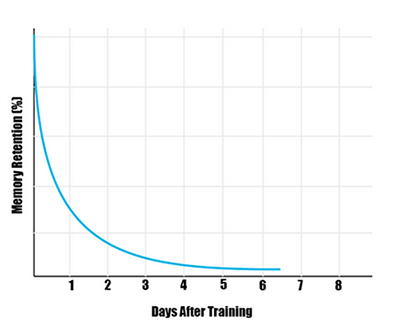Imagine you’re put in charge of your company’s biggestleadership training program. You do everything right: you conduct extensivediscovery with your subject-matter experts, you spend weeks authoring thestoryboard, your executive team signs off, and you deliver a stellar trainingexperience. Everything goes beautifully and everyone agrees the training was ahuge success. Your work is done.
But back in your office, while you bask in the glory of yoursuccess, a dreadful thing is happening inside the brains of your students. Theneural networks that your training inspired are beginning to dissolve, and as aresult, your employees are quietly forgetting almost everything you presented.
How bad is the problem? How much do people forget? Research onthe forgetting curve (Figure 1) shows that withinone hour, people will have forgotten an average of 50 percent of the information youpresented. Within 24 hours, they have forgotten an average of 70 percent of new information,and within a week, forgetting claims an average of 90 percent of it. Some people remember more or less, but in general, the situation isappalling, and it is the dirty secret of corporate training: no matter how muchyou invest into training and development, nearly everything you teach to youremployees will be forgotten. Indeed, although corporations spend 60 billiondollars a year on training, this investment is like pumping gas into a car thathas a hole in the tank. All of your hard work simply drains away.

Figure 1: The forgetting curve
And it gets worse. Given that our employees forget most ofwhat they learn, we should have no hope that our training will transfer back tothe workplace. After all, memory is a necessary condition for behavior change,and if your employees have forgotten the lessons of your leadership seminar,there is no reason to expect them to become more effective leaders back in theworkplace.
Why do peopleforget so much?
As a learning professional, it is essential that youunderstand why we forget, and so I will address the issue this month. Nextmonth, I begin discussing ways to overcome the forgetting curve.
Everyone is always bragging about the power of the humanbrain. So if it is so darned powerful, why does it fail so often? Why do weforget 90 percent of what we learn within one week? From the perspective of aneuroscientist, this question speaks to a fundamental misunderstanding aboutthe brain and about forgetting. Whereas most people think of forgetting as afailure of memory, “I forgot because my memory failed,” in professionalneuroscience, forgetting is not thought of as a failure at all. Insteadforgetting is thought of as a natural, adaptive, and even desirable activity.
Let me explain. At this moment, thousands of sensory inputsare inundating your brain and your brain is busy … ignoring them. Forexample, sensory impulses are racing from your left ankle telling your brainabout its position in space. However you were not aware of this sensoryinformation until I brought it to your attention because your brain wasactively suppressing that input. Simultaneously, other inputs are arriving andyour brain is ignoring them too. For example, your brain is ignoring thebackground noise in the room, the feel of clothing against your shoulder, andperhaps a faint odor of coffee in the room.
You get the idea … at every moment sensory information isflooding your brain, and your brain actively suppresses most of it usingcenter-surround neural networks (see the end of the article for moreinformation). This suppression is highly adaptive because, by suppressing mostinformation, you are now free to focus on what you think are the one or twomore essential pieces of information.
You need to experience this for yourself. Please watch this 90-second YouTube video and discover how our selectiveattention makes us oblivious to most information in the environment.
Avoiding memoryoverload
If our brain suppresses active sensory inputs, it also needsto suppress active memories so that it can focus only on essential information.When you think about it, every minute of the day we receive a river ofinformation that is relevant only for a short period of time. For example, youmay have remembered the phone number of a restaurant for a couple of minutes,but then it was no longer useful, and your brain managed to quickly forget it. Likewise,you parked your car last Thursday and you remembered where it was for the restof the day, but now that the information is no longer useful, your brain hasforgotten it.
The point here is that your brain needs to forget things thatare no longer useful. And this forgetting is inevitable, it is useful, and itis adaptive because it clears your memory for things that are more relevant. Theproblem, however, is that in the process of all of this memory purging, ourbrain often forgets important information.
Is there anyhope?
Your leadership training did indeed go well and you deservecredit for it. But when you go back to your office, you can’t afford to bask inyour success because, although the training went well, the ideas are quicklyand quietly leaking out of the gas tank. But here is good news and there ishope.
Although the brain will inevitably purge most of what itlearns, it does retain some information, and contemporary neuroscience hasdiscovered the signals that teach your brain which signals to remember andwhich information to purge and which information to retain. Next month, we willteach you ways to talk to the brain, and tell it to retain the importantinformation.
Digging deeper
If you want to dig deeper, here are some great resources:
This two-minute YouTube video provides a great introduction to neural networks
Learn about Center-Surround neural networks (advanced)










